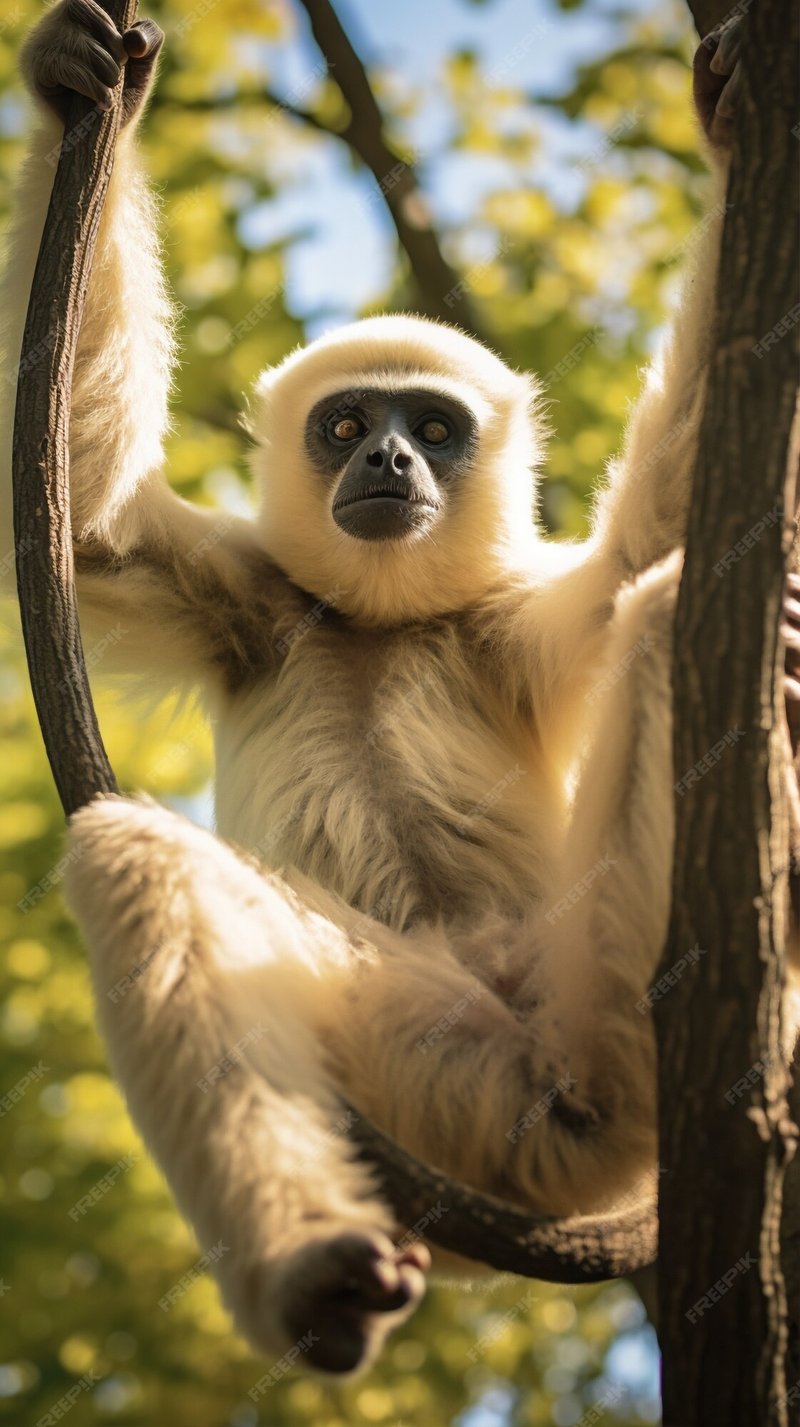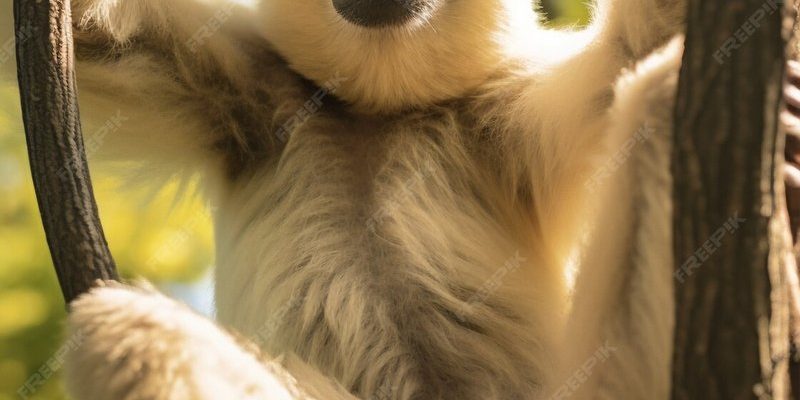
Gibbons are part of the lesser ape family, and they live in tropical forests across Southeast Asia. Their diet is primarily plant-based, but they’ve got some clever hunting tactics up their sleeves. Picture a gibbon quietly observing the jungle from a high branch, waiting patiently for just the right moment to snatch something delicious. This blog will explore what gibbons eat, how they hunt, and why their strategies matter in the grand scheme of their ecosystem.
Understanding the Gibbon’s Diet
When we think about gibbons, we often picture them swinging from branch to branch, but their diet is critical to their survival. Gibbons are primarily frugivorous, which means they love fruit! However, their menu is a bit more varied than just apples and bananas.
Gibbons typically munch on:
- Fruits: They’re particularly fond of ripe, juicy fruits like figs, mangoes, and durians.
- Leaves: Sometimes, they’ll snack on young leaves, especially during fruit scarcity.
- Flowers: Yes, gibbons even eat flowers; certain types can be quite tasty!
- Insects: Occasionally, they supplement their diet with insects like ants and caterpillars for extra protein.
The variety in their diet helps them adapt to different habitats. While gibbons primarily eat fruits, they know how to switch things up based on what’s available. Honestly, this flexibility is crucial, especially when certain fruits aren’t in season. So, gibbons play an essential role in their ecosystem by helping to disperse the seeds of the fruits they consume.
How Gibbons Hunt for Food
Gibbons might not be traditional hunters like big cats, but they’ve got their own ways of getting food that are just as effective. Their hunting technique often looks more like a dance than a choreographed plan. You might be wondering, how do they actually get their grub?
Let me explain their approach:
Firstly, gibbons use their heightened senses to spot food from afar. They’ll climb to a high point where they can scan their surroundings. Next, they engage in a process called “grooming for food,” where they’ll inspect trees for the ripest fruits. Just imagine them, hanging upside-down, peering at a cluster of figs, and then swinging down for the catch!
They also use teamwork. When living in family groups, gibbons communicate with one another through loud calls. This vocalization not only strengthens family bonds but also alerts their companions to food locations. Isn’t it amazing how they coordinate? They seem to have their own little “hunting meetings” right in the treetops.
The Role of Gibbons in Their Ecosystem
It’s easy to focus on how gibbons hunt and eat, but let’s take a step back and look at the bigger picture. Gibbons play a crucial role in maintaining the health of their forest habitats. By dispersing seeds, they help new plants grow, which benefits other animals and plants in the area.
Here’s the thing: when gibbons eat fruit, they often swallow the seeds whole. Later, when they move around, they excrete these seeds in different locations. This process is known as seed dispersal. It’s like the gibbons are little gardeners, nurturing the forest as they go about their daily lives! If gibbons were to disappear, the variety of plants could dwindle, impacting countless other species.
Also, their feeding habits create a natural balance within the ecosystem. When they munch on certain plants, it can promote new growth by allowing sunlight to reach the forest floor. Gibbons are not just surviving—they’re thriving in a way that supports the biodiversity of their environment.
Social Behavior During Feeding
Gibbons are fascinating because they’re not solitary creatures, unlike many other primates. Their social structures often revolve around family units, which can make feeding time a social event! You might find them grooming each other and sitting close while munching on fruits.
During these feeding times, it’s common to see playful interactions. Young gibbons learn about food and foraging by watching their parents. It’s almost like a natural classroom in the trees! They imitate their parents, testing out their skills and developing their own strategies.
This social behavior makes for a lively atmosphere in the forest. The gibbons call out to each other, sharing the joy of a good meal. You can almost hear them cheering each other on as they find ripe fruit. This communal feeding not only strengthens bonds but also enhances hunting efficiency, as they can cover more ground together.
Adaptations for Successful Hunting
Gibbons possess some remarkable adaptations that make them efficient foragers. Their long arms and powerful muscles allow them to swing seamlessly from branch to branch, making them one of the best tree-dwellers in the animal kingdom. Their hands are perfectly designed for gripping, helping them hold onto branches while reaching for food.
Another interesting adaptation is their keen eyesight. Gibbons have exceptional vision, which helps them spot fruits at a distance. Imagine having binoculars for eyes! This sharp vision comes in handy when they’re looking for their next meal or trying to avoid potential predators.
Their agility is not just for show; it serves a functional purpose in hunting. Gibbons can move quickly and quietly through the treetops, allowing them to sneak up on their food. This stealthy approach makes them effective foragers, and combined with their vocal communications, they become a dynamic force in their environment.
Challenges Faced by Gibbons in Foraging
Even though gibbons are well-adapted to their environment, they still face challenges when it comes to foraging. Habitat loss is a major issue. With deforestation and land development, many gibbon populations find it increasingly difficult to find adequate food sources.
As their habitats shrink, the variety of plants they rely on can diminish, leading to food scarcity. Imagine trying to find your favorite restaurant in a city that’s being constantly redesigned—it becomes frustrating and challenging!
Another challenge is climate change. Shifts in weather patterns can affect fruit availability. For instance, if a drought hits, there might not be enough fruits for gibbons to eat, which can impact their health and reproductive success.
Lastly, gibbons are sometimes hunted by humans or kept as pets, further threatening their survival. These factors make it even more important to understand their role and to protect their habitats, so future generations can enjoy the beauty of gibbons in the wild.
Gibbons are not just performers in the jungle circus; they are essential players in their ecosystems. Understanding their diet and hunting strategies sheds light on how they thrive amidst challenges. They teach us about the balance of nature—how every creature, big or small, plays a role in maintaining the health of our planet.
So, the next time you think of gibbons, picture them swinging through the trees, calling to one another, and playing their part in the grand design of nature. Protecting their habitat is crucial, not only for their survival but for the health of the entire forest ecosystem. Let’s appreciate these amazing creatures for all they bring to our world!

